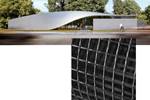ITA acquires composites 4.0-enabled BIAXTRONIC warp-knitting machine from Karl Mayer
This latest technology will aid development of open-meshed textile grids and non-crimp fabric structures for composites and concrete reinforcements.

BIAXTRONIC warp-knitting machine and new research opportunities. Source | ©Karl Mayer
The Institut für Textiltechnik (ITA) of RWTH Aachen University (Aachen, Germany), a renowned institute worldwide in the field of textile technology and member of the composites consortium AZL Aachen, has procured a BIAXTRONIC high-performance warp-knitting machine with course-oriented weft-insertion system from Karl Mayer (Obertshausen, Germany). ITA will use the BIAXTRONIC for the development of knitted open-meshed textile grids and non-crimp fabric structures for fiber-reinforced composites and reinforced concrete applications.
Technical textiles play a central role in all areas and application fields of ITA. The ITA Construction Composites research group, as part of the Collaborative Research Centre 532, have developed textile reinforcement structures for concrete matrices with the help of the current in-house machine (Karl Mayer Malimo) from 1999 to 2011. Procurement of the BIAXTRONIC will enable further development and production of reinforcement structures for concrete matrices. The new machine will also be used for the development of functional samples/prototypes in other application fields such as:
- Production of hybrid knitted fabric structures over a non-woven substrate;
- Reinforcement of wound dressings in the medical textiles sector;
- Manufacture of unidirectional (UD) fabrics for fiber-reinforced plastics and plain knitted fabrics for thermal textiles in the mobility sector.
The new machine platform features technologies that open up new research avenues for ITA and its research partners. The possibility to feed in a base substrate will allow ITA to fundamentally research applications in the field of geotextiles. The machine also includes the Karl Mayer Command System “KAMCOS” with an ethernet interface for integration into an existing network. This fulfills the requirements for research topics in the field of Industry 4.0, as well as inline quality control and networking of the process chain. The newly developed electronic guide bar control system and the possibility to vary process parameters inline will improve the product quality substantially and help in producing locally-adapted and tailored textiles.
ITA thrives on the development of innovative technologies and products, which mainly result from bilateral research projects between industry and universities. Thus, with the acquisition of the BIAXTRONIC, ITA is looking to undertake collaborative projects with national and international partners in the coming years. ITA also plans to unveil the BIAXTRONIC on Jan 21, 2021 and cordially invites interested partners to attend the one-day industry event in Aachen.
This acquisition of the BIAXTRONIC is funded by the Deutsche Forschungsgemeinschaft (DFG, German Research Foundation) and the state of North Rhine-Westphalia, project number INST 222/1264-1 FUGG. ITA extends its gratitude towards the DFG and the state of North Rhine-Westphalia for their financial support.
Please contact Shantanu Bhat at shantanu.bhat@ita.rwth-aachen.de regarding more information or further interest.
Related Content
-
ST Engineering MRAS presents initiatives to drive autoclave efficiency, automation
During a JEC World 2024 panel discussion, the company revealed ways in which it is maximizing throughput and efficiency of its autoclaves and enhancing composites production processes.
-
Schrödinger advances materials informatics for faster development of next-gen composites
Cutting time to market by multiple orders of magnitude, machine learning and physics-based approaches are combined to open new possibilities for innovations in biomaterials, fire-resistant composites, space applications, hydrogen tanks and more.
-
IMDEA introduces digital twin for real-time analysis of composite materials production
Newly designed digital twin by IMDEA and Technical University of Madrid researchers enables manufacturers to see inside composite materials as they are being produced, facilitating early detection of faults.
















